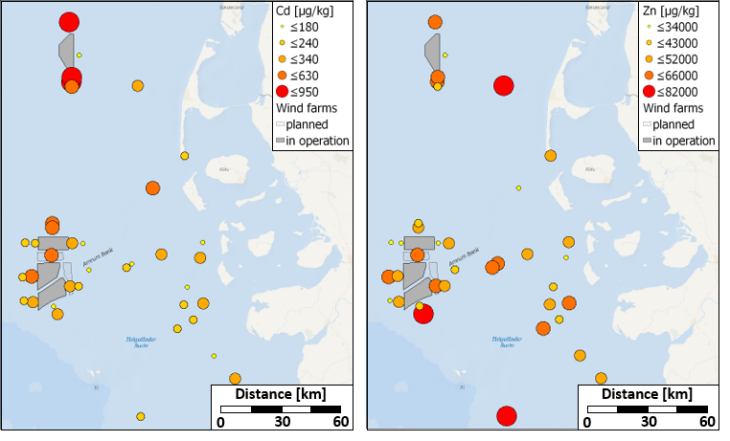Offshore Wind Farms
During the last decade, the North Sea has experienced a considerable increase in offshore wind farm development. At the end of 2016, the capacity in the North Sea has reached a total capacity of 9.1 GW with 44 wind farms and over 2700 individual piles. By 2020, the total offshore wind capacity is expected to be 24.6 GW.
This rapid transformation of the southern North Sea into an energy seascape may compromise environmental development goals stipulated by national and international legislation. It bears conflict potential with other natural resources, such as fisheries.
In interaction with departments at Hereon, scientists at the Institute of Coastal Environmental Chemistry are analysing the effects of offshore wind farms. Aspects of their investigations are biogeochemical pollution effects.
Biogeochemical Pertubations

Initial results of mapping heavy metal sediment concentrations in the vicinity of wind farms and background reference areas in the German Bight. (Graphic: Ulrike Kleeberg, Daniel Pröfrock / Hereon)
The large-scale construction of offshore wind farms may have effects on the marine environment through introduction of new pollution sources. Examples are steel-reinforced foundations, scour prevention by geotextile sand containers, anti-corrosion measures (coatings, anodes) for pile protect, and activities related to regular maintenance.
Geotextiles used for scour protection around piles are permeable fabrics and mostly based on polyethylene or polypropylene. These fabrics typically contain plastic additives, such as plasticizers, UV-stabilizers, and flame retardants. Since additives are not chemically bound to the plastic material, they are leached by seawater and/or are accumulated by biota settling on the fabric after deployment.
Current research carried out in collaboration with the Federal Maritime and Hydrographic Agency also concentrates on possible pollution by sacrificial anodes and surface coatings used to protect offshore wind turbines against corrosion. Such investigations provide important information relevant for design specifications and the approval process for new wind farms by the Federal Maritime Agency.
